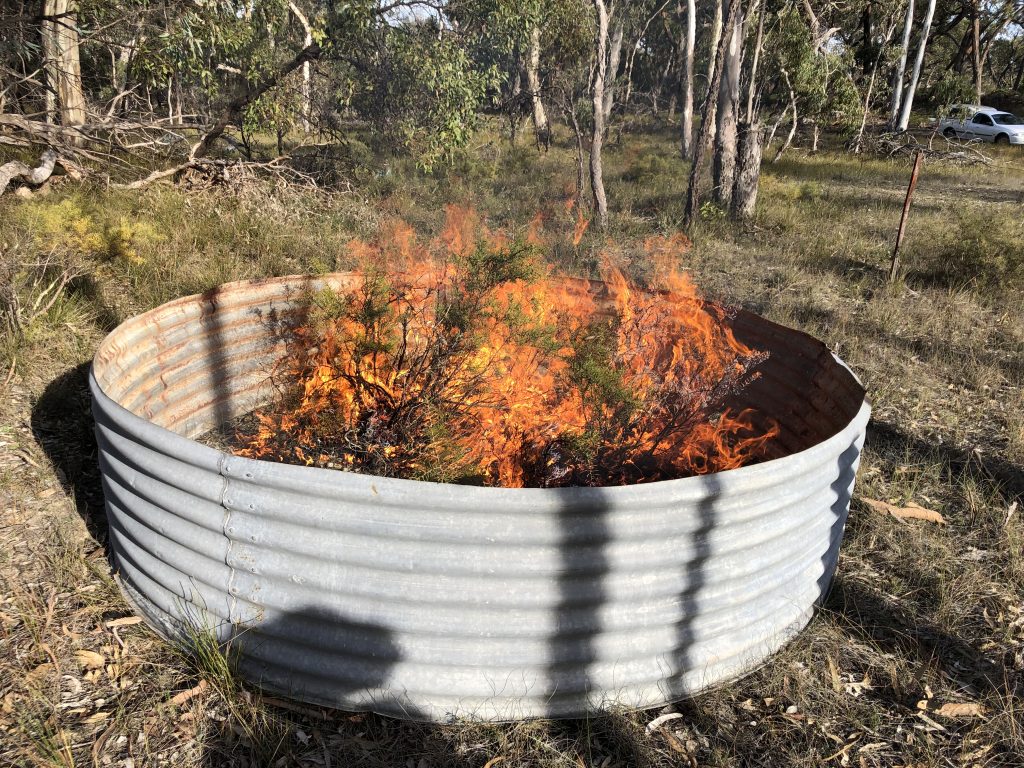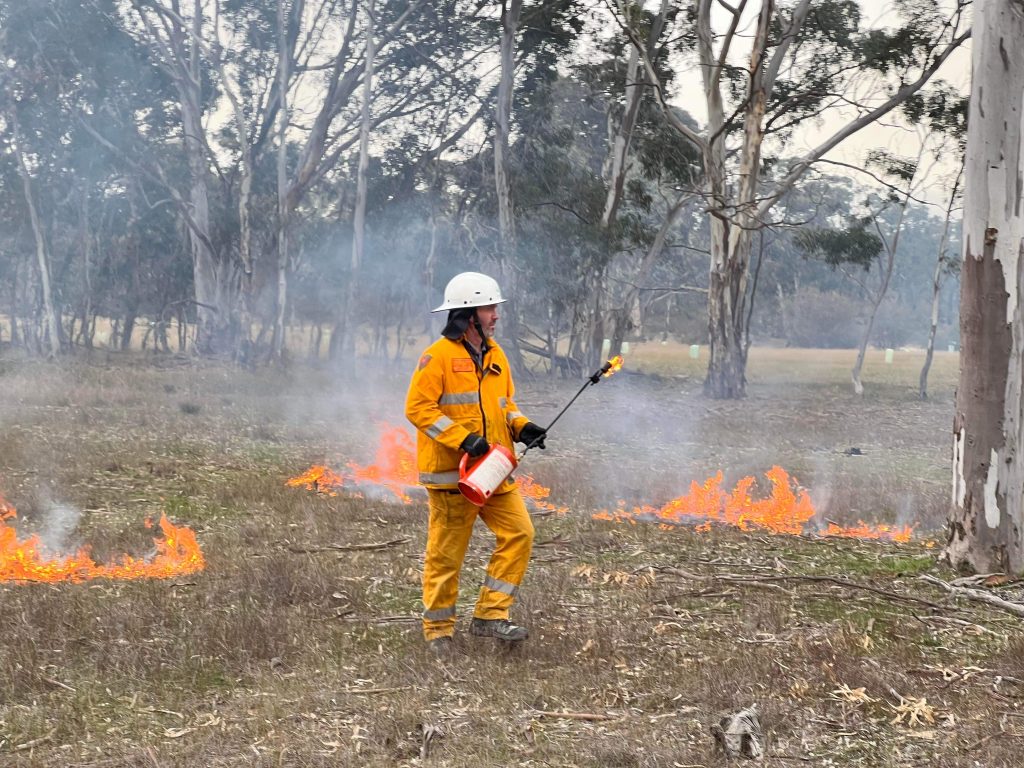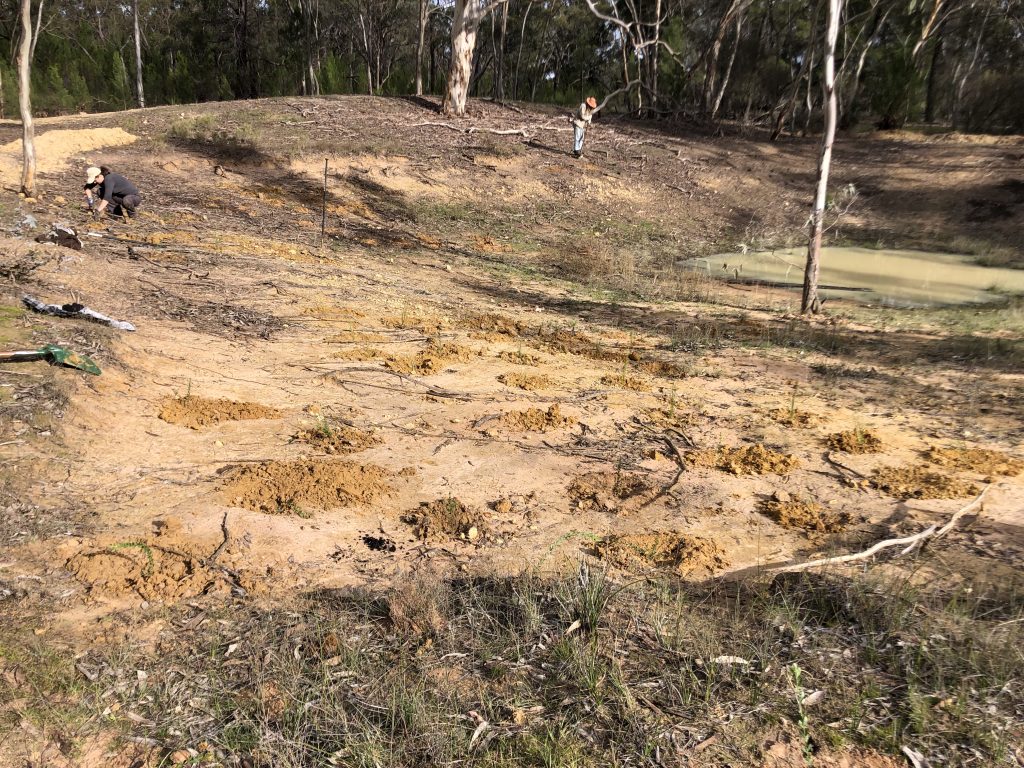Repairing the past at private land conservation sites – Part III – burning and culture
It has been six months since we last wrote to you about the ‘Repairing the Past’ project, so we have lots to report! You can catch up on previous posts from November 2021 and January 2022.
Several actions have gone ahead in leaps and bounds, with walks on country, burn plans completed, dam decommissioning commenced and burns undertaken on two properties during autumn this year.
Walk on Country at Heritage Agreement (HA 1467) with Craig and Jo
Uncle Ken Jones (as the South East Aboriginal Focus Group representative) made the trip up to Craig and Jo’s property for a walk on country back in November 2021. The purpose of this outing outing was for like-minded landholders with an interest in fire and traditional land management practices to meet, and was also a chance for an elder to walk over country and offer insight and/or advice on cultural matters or items of interest. The weather wasn’t kind to us that day as it reached the high 30s while blowing a gale for most of the day, but we soldiered on. A good cuppa and a biscuit fixes nearly everything!

Craig and Jo talked us through the numerous activities they have undertaken over the years (including rabbit control and revegetation) and Uncle Ken was given the opportunity to walk and drive around most of the boundary and sites of interest to see the extent of the habitats and any culturally important components. At one point we stopped to appreciate the value of grass trees (Xanthorrhoea spp.) where a patch of large X. australis were seen with exuded gum on their trunks. Uncle Ken talked with Craig and Jo about how pieces of gum (especially from grass trees) is tough, flexible and water resistant when mixed with other natural materials (like kangaroo dung and charcoal) helping to create a glue which is then suitable for repairing string, water carriers and canoe’s.
An extract from comments made by Uncle Ken summarised the property well: “pristine shrubland, vast areas of Banksia forest, ancient grass trees, and sand dunes”. What a great spot.
Dam decommissioning works completed for three dams and inspected for cultural heritage
Speaking with local Indigenous community members back in October 2020 at the inception day at Binnum Bushland, it was decided as a group, that back-filling dams will no longer be undertaken. Dams are considered an essential habitat for eastern long-necked turtle in the upper South East region with the decline in wetland extent influenced by numerous factors including reducing groundwater levels and heightened by a drying climate. The long-necked turtle is a totem to First Nations people and the group felt it best to avoid filling in dams to reduce the chance of unintended smothering of hibernating tortoises in the mud with several feet of soil over the top. Instead, an alternative method was agreed upon in which bunds (embankments) are created on the sides of dams which should sufficiently prevent surface water from flowing off the flats – as had been trialed previously at Eaglehawk Waterhole. This post from 2017 which provides a good example of the intent of this approach i.e. water lying on the flats as a result of a wet winter-spring and small bunds created by the hands and shovels of volunteers. If groundwater levels are sufficiently close to the surface, then an expression of groundwater in the dam occurs creating a natural waterhole for wildlife. This concept seems appropriate as all three dams at Eaglehawk Waterhole where this process has been carried out are currently holding surface water.
One of the most rewarding components of this activity though has been the involvement of a local volunteer. Nearby farmer, and active Field Naturalist Society member, Phil Verco offered NGT assistance with the dam decommissioning component. Phil brought his tractor and created 500-600 mm high bunds preventing surface water from the surrounding wet flats entering the dams. He was excited by the chance to help, but not as much as we were appreciative of his assistance and supply of equipment for the day.
An important task after the movement of the spoil heaps (to create the bunds) was to inspect for cultural artefacts and/or remains. No artefacts or remains were found, but we thank Uncle Ken Jones for inspecting these areas as a representative of Burrandies Aboriginal Corporation.

Burn plans prepared, submitted and approved for Eaglehawk Waterhole and Binnum Bushland
Another important aspect of this project has been preparation for prescribed burning. The act of burning bushland on private land is permitted in South Australia; however, not without a few checks and balances. Therefore, prescribed burn plans were required for both Binnum Bushland and Eaglehawk Waterhole outlining the where, why and how for each burn site including a flora list, threats and pre- and post-burn actions. The plans were then provided to the local regional ecologist and Indigenous advisor, local Councils, CFS region 5, local CFS brigades and the Native Vegetation Council for approval. Quite a list of stakeholders, but in the end we achieved our goal of seeking approval – and received the go ahead in late March 2022.
Two types of burns were approved, one using small containers and the other a more traditional wind assisted woodland burn, both with no mineral earth fire breaks required. The container burns were planned for Binnum Bushland with Uncle Ken preparing sections to burn inside old corrugated iron water tank, then once a burn was complete the tank could simply be moved to a new location.
May 24th was the day for the burning at Binnum Bushland and we were fortunate to have neighbours and other community members also join us. Multiple small burns were lit in various habitat types ensuring a diversity of bushfood plants were burnt and increasing the potential for a diverse flora recovery. Each burn lasted only a few minutes and was then extinguished with water. The burn intensity ranged from low to high with flame heights of 0.2 m up to an unexpected >3 m in some cases. This variation in intensities will help to mirror a larger scale warm to hot fire in each habitat type. Local CFS member Evan Roberts kept an eye on proceedings and extinguished each fire as they were completed. Family and community members were present during the day which added great value to the social setting of the day (and offered amazing food – thanks Liz and friends!). People of all ages and physical abilities attended which was great to see. A small donation was made towards the Royal Flying Doctor Service as a result of the catering on the day. Over 15 burns, across five sites, were achieved at Binnum Bushland and we aim to return in September to see the results – See a summary in this short video.
Although Burrandies Aboriginal Corporation crews had to pull out of the burns, we are pleased to hear that steps are in place for members of community to undertake fire training so that participation in future burns at these private properties will be possible.

Uncle Ken and I also had time to complete a second burn this time on Eaglehawk Waterhole. The weather was perfect, being calm and sunny, with rain imminent from the west and the breeze starting to pick up. We found a spot which we lit it up on a northerly breeze with the natural vegetation boundaries and wind direction making it an easy and safe burn to achieve – avoiding the need to disturb the soil for a mineral earth break in what is pristine woodland.

Seedlings ready for dam plantings
We are revegetating the three decommissioned dams at Eaglehawk Waterhole with seedlings grown in NGT’s nursery. The planting design has focussed on providing a dense cover inside of the dams with sedges and small shrubs including basket weaving plants, grasses and wattles. Other local indigenous bushfood plants will be planted around the outside and surrounds.
The NGT crew began this year’s plantings on Friday 17th June, before we were joined by supporters the following day at the NGT 10 year anniversary event at Eaglehawk Waterhole. Over the two days we planted about 500 seedlings. We have arranged a further planting day with Frances Primary School for the third dam and we will report this in our next post.

This project is funded through the South Australian Government, devolved by the Revitalising Private Conservation in South Australia pilot project – working in partnership with Nature Foundation, Livestock SA, Trees For Life, Nature Conservation Society SA and Conservation Council SA.
